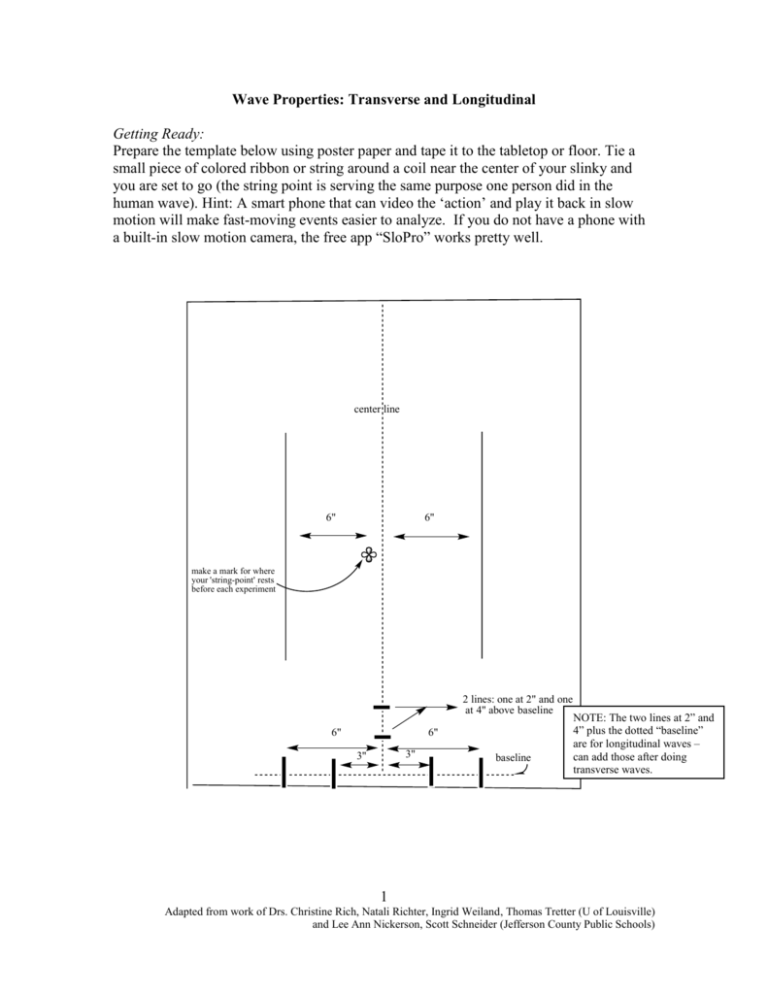Slinky group work packet
advertisement

Wave Properties: Transverse and Longitudinal Getting Ready: Prepare the template below using poster paper and tape it to the tabletop or floor. Tie a small piece of colored ribbon or string around a coil near the center of your slinky and you are set to go (the string point is serving the same purpose one person did in the human wave). Hint: A smart phone that can video the ‘action’ and play it back in slow motion will make fast-moving events easier to analyze. If you do not have a phone with a built-in slow motion camera, the free app “SloPro” works pretty well. center line 6" 6" make a mark for where your 'string-point' rests before each experiment 2 lines: one at 2" and one at 4" above baseline 6" 6" 3" 3" baseline NOTE: The two lines at 2” and 4” plus the dotted “baseline” are for longitudinal waves – can add those after doing transverse waves. 1 Adapted from work of Drs. Christine Rich, Natali Richter, Ingrid Weiland, Thomas Tretter (U of Louisville) and Lee Ann Nickerson, Scott Schneider (Jefferson County Public Schools) Transverse Waves The idea here is to recreate the transverse wave you generated as a human wave…but by using a slinky to reproduce the transverse wave motion. Explore what causes changes in wave frequency, wavelength, and amplitude. Position the slinky along the center line and use the 3” and 6” vertical marks to help make your observations semi-quantitative. Video the slinky and its motion with your slow motion camera and replay in slow motion to get more insight. Your goals for this exploration: 1. Diagram the wave motion and label the features (crest, trough, wavelength, amplitude, etc.) of the wave. 2. Draw a vector on each diagram that shows the direction of energy flow. (Where are these waves getting their energy, anyway?). How are changes in amplitude related to changes in the energy of the wave? Again, make some inference statements about the changes. 3. Observe the position of the ‘string’ point before, during, and after creating a wave. Describe how the point’s position changes during and after the wave’s propagation. Be able to describe changes in the string point’s displacement as a result of changes in frequency, amplitude, and direction of energy flow. 4. Identify the wave medium. How do waves generated by the metal slinky compare to those generated with the plastic slinky? Describe the difference between wave “speed” and wave “frequency.” Mathematical extensions (high school): Using the evidence you’ve generated, develop a mathematical relationship among frequency, wavelength, and speed of a metal slinky wave. Repeat for plastic slinky. BONUS: Using sinusoidal functions, choose one of your generated waves, sketch that wave (including appropriate quantitative scale measures), and represent this wave with a mathematical function. 2 Adapted from work of Drs. Christine Rich, Natali Richter, Ingrid Weiland, Thomas Tretter (U of Louisville) and Lee Ann Nickerson, Scott Schneider (Jefferson County Public Schools) Longitudinal Waves We just generated a human longitudinal wave and noted some of the features. Seems much different from transverse, doesn’t it? Using a slinky and your template, explore the behavior of longitudinal waves…sometimes called compression waves. For this exploration of amplitude, frequency, etc. you want to use the 2” and 4” horizontal lines as starting points for your wave generation. It’s much harder to see what’s happening with longitudinal waves in real time. Video it and replay in slow motion to get more insight. Your goals for this exploration: Generate a model diagram of a longitudinal wave propagating down the slinky. The distance between the lines should mimic the distance between the coils of the slinky. Label the areas of compression, areas of rarefaction, and indicate a wavelength on your diagram. Convert your model diagram from above (1-dimensional) of the longitudinal wave to a 2-dimensional plot with density on the vertical axis. How does this diagram compare to a plot with pressure on the vertical axis? Think about the video(s) you just captured. How were you able to change the variables of frequency and amplitude in the generation of a longitudinal wave? Make some inference statements about how wavelength relates to frequency and amplitude (e.g., When frequency increases, the wavelength…). Generate model diagrams (both 1- and 2-dimensional) for each of the following scenarios of a longitudinal wave: low frequency with low amplitude; low frequency with high amplitude; high frequency with low amplitude; high frequency with high amplitude. Note: you should have a total of 8 diagrams here. Draw a vector on each diagram that shows the direction of energy flow. (Where are these waves getting their energy, anyway?). How are changes in amplitude, frequency, and wavelength related to changes in the energy of the wave? Again, make some inference statements about the changes. Observe the position of the ‘string’ point before, during, and after creating a wave (reminder: the string point is serving the same purpose one person did in the human wave). Describe the point’s displacement relative to the direction of the wave. Be able to describe changes in the string point’s displacement as a result of changes in frequency, amplitude, and energy flow. Wrap-up Video: YouTube Sound + Fire = Rubens' Tube http://www.youtube.com/watch?v=1ZcOusmB4Ls&index=128&list=UUHnyfMqiRRG1 u-2MsSQLbXA Processing: Use a box and T to summarize the similarities and differences between transverse and longitudinal waves. Things to consider: terminology, energy flow, movement of the particles of the medium relative to the direction of energy flow. 3 Adapted from work of Drs. Christine Rich, Natali Richter, Ingrid Weiland, Thomas Tretter (U of Louisville) and Lee Ann Nickerson, Scott Schneider (Jefferson County Public Schools)








